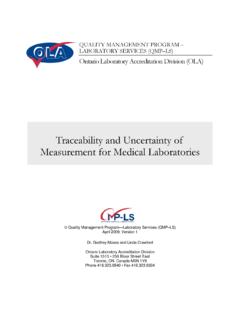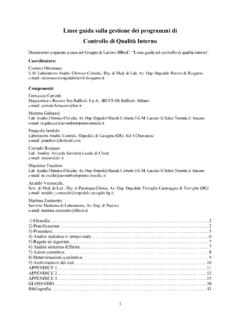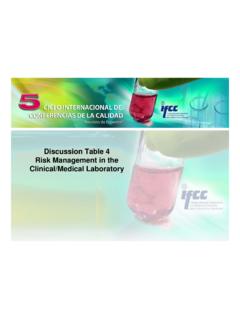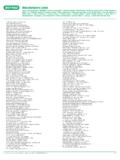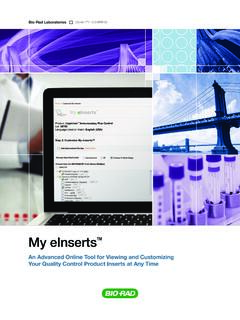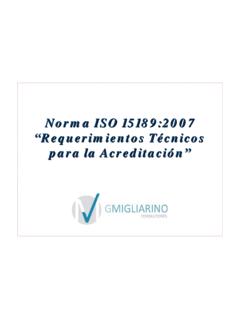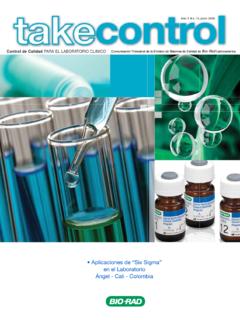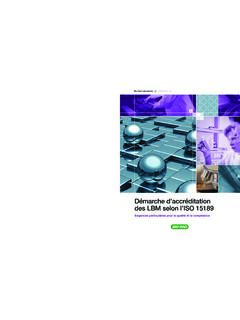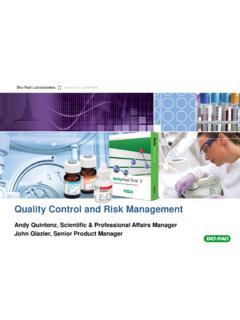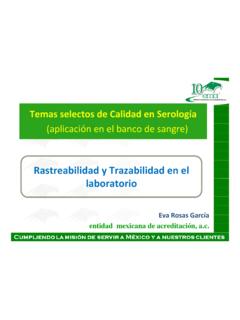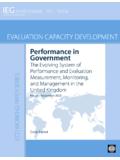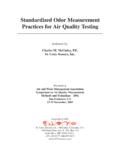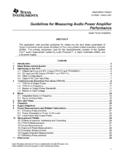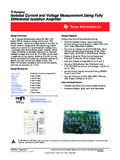Transcription of Measurement Uncertainty - How to Calculate It In …
1 11/18/20091 Moses, GC; GDMLM easurement Uncertainty - How to Calculate It In The Medical LaboratoryGodfrey C. Moses, PhD, FCACBN ational Director, Gamma-Dynacare Medical Laboratories11/18/2009 Moses, GC; GDML2 IntroductionDisclaimers Procedure that I will be describing is not an approved OLA method but the contents are based largely on the information in the 2 OLA documents published in QMP-LS News, as well as on other peer reviewed PowerPoint Presentation Lacks Power & has no Point!!11/18/2009 Moses, GC; GDML3 Objectives Brief Introduction on UM concepts Overview of available methodology Description of the method/procedure used at GDML Some examples from GDML, Ottawa & Brampton Labs and Dr Lynn Allen s Questions/Discussion as time permits11/18/2009 Moses, GC.
2 GDML4 Definitions of Uncertainties UM: A parameter, associated with the result of Measurement , which characterized the dispersion of the values that could reasonably be attributedto the measurand (the quantity intended to be measured) U ( Uncertainty ): Parameter obtained from measurements, which serves, together with the Measurement result, to characterize a range of values for the true valueof the measurand Uncertainty of the Result: Estimated quantity intended to characterize a range of values which contains the reference value, where the latter may be either the true value or the expectation, depending on definition or agreementRef EuroLab Technical Report 2006: Guide to Evaluation of MeasurementUncertainty for Quantitative test , GC.
3 GDML5UM concepts Consists of Several Components Methods for Determining it Consists of Several Steps One or More and/or Combination of Approaches are Acceptable Applicable to a Measurement Procedure (Test or Analyte Procedure) Not to a Series of Replicate Measurements Steps include Specifying the measurand and the Measurement procedure Defining input quantities and identifyinguncertainty sources Determining& quantifyingsignificant Uncertainty sources Assessingwhether correlation exists between contributing sources of Uncertainty Calculatingthe combined standard Uncertainty & definingthe coverage factor11/18/2009 Moses, GC; GDML6UM concepts Why should medical labs determine UM?
4 A. Requirements for Accreditation (Regulatory) International standards requiring traceability of lab results/information to acceptable international reference (procedure or material) JCTLM (IFCC, ILAC & CIPM) Manufacturers/Vendors COA (certificates of analyses) must state concentration and Uncertainty of standards/calibrators. B. Quality Laboratory services are essential to patient care (ISO 15189:2003); level of performance required for intended use; UM is another measure of quality 11/18/2009 Moses, GC; GDML7UM concepts NPAAC s (Australia) MU is one of the major potential contributors to the Uncertainty of results interpretation, and laboratories should have such data available for clinical users ( ) APLAC s (Asian-Pacific Lab Accreditation Cooperation) TC 010 (2009).
5 Many important business decisions are based on the results obtained from quantitative testing. It is important that an indication of the quality of reported numerical test resultsis available to you ( ).11/18/2009 Moses, GC; GDML8 Overview of not a single standardized method; different approaches are acceptable as long as GUM are Modeling (equation or algorithm, modeling the analyte/test as a function of relevant inputs2. Within or Single Lab Validation QC Data3. Between or Inter-laboratory Comparison Data4. Proficiency Testing Data (between lab comparison with estimate of bias relative to reference ( Reference value; AMM; AMTM) (2 3 5 Top-Down Alternatives11/18/2009 Moses, GC; GDML9 Bottom-up Mathematical Modeling Approach of GUM Function of various inputs Mathematically complex equations Uncertainty budgets Correlations and co-Variances Not Suitable for routine use11/18/2009 Moses, GC.)))
6 GDML10 Within-Lab reproducibility (imprecision) and accuracy using suitable reference and QC materials Compare lab s results with those from a reference procedure run in parallelBias = (meanobs ref)Imprecision = SDr = SQRT of Sum (obs - meanobs)squared divided by (nobs 1)Within/Single Laboratory Validation and QC Data11/18/2009 Moses, GC; GDML11 Inter-laboratory Comparison Data Reproducibility SD for labs involved (SDR) Test performance conform to standards Testing conditions are same in the labs and/or associated with suitable reference procedure11/18/2009 Moses, GC; GDML12 Inter-Laboratory Comparison for Proficiency Testing Successful Participation in Inter-Lab Proficiency Testing Program Useful in Assessing Bias and Associated UM ubias= (RMSyour lab2+ uref2)^.
7 Ref value given ubias= (RMSyour lab2+ SR2/n)^ ..ref value not given Combined standard Uncertainty uc= [SDm2+ ubias2]^ , GC; GDML13 Combined Alternative Approach Top-down alternative approach with internal QC and PT Results 6-step approach; PT results from EQA (QMP-LS) and DigitalPT MS Excel (1 worksheet each Test selection, Method SD determination; Bias estimation; UM calculation) Method SD from internal QC; multiple analyzers/modules over six months Bias and Z-value (SDI, bias/method SD ratio); minimum of 3 surveys with 2 or more levels per survey Combined and expanded Uncertainty of Measurement calculated as absolute and relative (%) values Details about this topic11/18/2009 Moses, GC; GDML14 Calculating Method/Procedure SD Average or Pool (Type A or B) Internal QC Data; Min.
8 6 months Type A (Averaged) - per QC or per Analyzer {[(SD2)L1+ (SD2)L2] / 2}1/2 Type A (Pooled) per all QC s and Analyzers [(n1SD12+ n2SD22+ .. nnSDn2) / (n1+n2+.. nn)]1/2 Type B (other) (HIGH LOW) / (12)^ (HIGH LOW) / (24)^ Typical semi-quants. with known cut-offs, lower and higher detection/measuring ranges ( Uncertainty known at both ends and need to Calculate combined standard Uncertainty )11/18/2009 Moses, GC; GDML15 Calculating Uncertainty Associated with Bias PT Data Uncertainty & Reference / Assigned Value Stated or known uB= [(RMSyourLab2) + (uCref2)]1/2 All Method Mean Provided as Target or Reference ValueuB= [(RMSyourLab2) + (SR2/n)]1/2SR is all method reproducibilityn is the number of labsRMS is Root Mean Square of Bias for your , GC.
9 GDML16 Calculating Combined Standard and Expanded UMCombined Standard, ucuc= [(uSD)2 + (uB)2]1/2= [(uSD)2+ (SEM)2+ (uCref)2]1/2= [(1/N SD2) + (uCref)2]1/2 Expanded Uncertainty , UU = Uc (~2); uB: SEM requires CRM s; Use RMS (root mean square) from PT results or assigned reference value for material tested by an internationally accepted reference = est SD at bias = 0 (both the actual bias and the variation of bias are considered)11/18/2009 Moses, GC; GDML17 Top-down Alternative Approach Steps Select/Define the test/analyte/examination (Measurand) 2. Determine method SD or CV; at least 2 levels; minimum of six months period.
10 3a. Estimate bias (absolute and/or relative) and SDI from PT (EQA, QMP-LS & DigitalPT, HealthMetrx; SDI = Abs bias relative method SD or CV) 3b. SDI < or = 2, Uncertainty associated with bias is not included in the calculation of the combined Uncertainty , uC 3c. SDI > 2, Uncertainty associated with the bias is included in the calculation of the combined Uncertainty , uC 4. Calculate uc, the combined Uncertainty from the pooled or individual QC SD s (steps 2 or 3) and the Uncertainty associated with bias 5. Calculate U, the expanded Uncertainty by multiplying the uc by coverage factor, k ( or 2; 95% CI) 6. U expressed as Abs or Relative (%) [Test/Analyte = measured value +/- U units]11/18/2009 Moses, GC; GDML18 Minimal UM Data Defining Test/Analyte Quantity Measurand Units Method Measurement Procedure Test limitations Clinically significant interferences Calibrator Measurement Uncertainty (uRef) Expressing UM - Analyte/Test: Result +/- U units eg Plasma or serum glucose: +/- mmo/L11/18/2009 Moses, GC.
